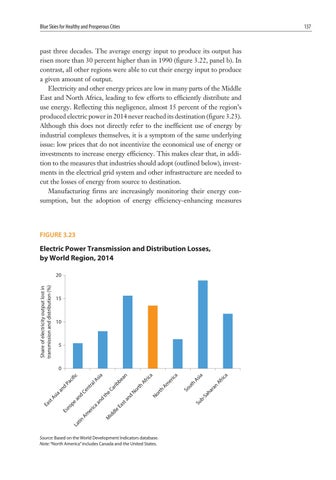Blue Skies for Healthy and Prosperous Cities
137
past three decades. The average energy input to produce its output has risen more than 30 percent higher than in 1990 (figure 3.22, panel b). In contrast, all other regions were able to cut their energy input to produce a given amount of output. Electricity and other energy prices are low in many parts of the Middle East and North Africa, leading to few efforts to efficiently distribute and use energy. Reflecting this negligence, almost 15 percent of the region’s produced electric power in 2014 never reached its destination (figure 3.23). Although this does not directly refer to the inefficient use of energy by industrial complexes themselves, it is a symptom of the same underlying issue: low prices that do not incentivize the economical use of energy or investments to increase energy efficiency. This makes clear that, in addition to the measures that industries should adopt (outlined below), investments in the electrical grid system and other infrastructure are needed to cut the losses of energy from source to destination. Manufacturing firms are increasingly monitoring their energy consumption, but the adoption of energy efficiency-enhancing measures
FIGURE 3.23
Electric Power Transmission and Distribution Losses, by World Region, 2014
Share of electricity output lost in transmission and distribution (%)
20
15
10
5
an
ut h
Af
ric
a
As ia
a
ar ah bS Su
Am rth No
d an st Ea
id M
Source: Based on the World Development Indicators database. Note: “North America” includes Canada and the United States.
So
er ic
ric Af rth No
Ca e th dl e
ica er Am
La
tin
a
be an rib
lA sia an
d
an e op Eu r
Ea
st
As
d
ia
an
Ce nt
d
ra
Pa
cif
ic
0






